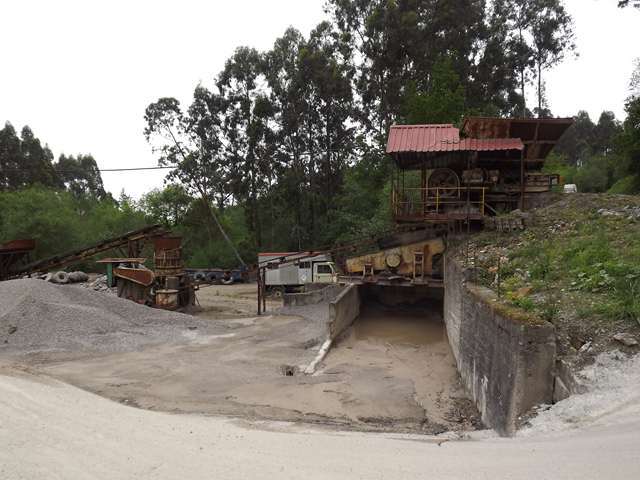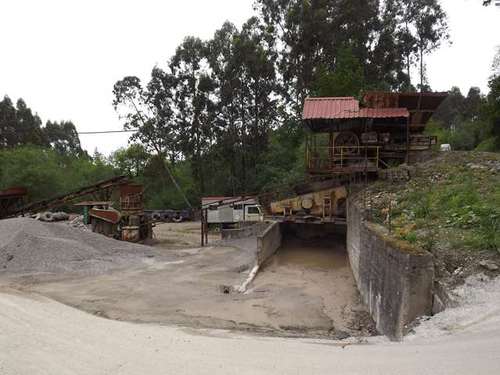Obdulia vein, Colunga, Asturias, Spaini
| Regional Level Types | |
|---|---|
| Obdulia vein | Vein |
| Colunga | Mining District |
| Asturias | Autonomous Community |
| Spain | Country |
This page is currently not sponsored. Click here to sponsor this page.
Latitude & Longitude:
43° North , 5° West (est.)
Estimate based on other nearby localities or region boundaries.
Margin of Error:
~121km
Type:
Mindat Locality ID:
224539
Long-form identifier:
mindat:1:2:224539:6
GUID (UUID V4):
3aa852ee-3183-49e5-8a9b-2355dc6d306f
Name(s) in local language(s):
Filón Obdulia, Colunga, Zona minera de Caravia, Asturias, España
The Obdulia vein hosts the Obdulia Mine, Jaimina Mine, and the following open cast quarries: Valnegro, Pie de Potro, El Fumo, El Coronel, Llamas. Finally, it also hosts the Llamarga and Margolles mines.
(Note that the Obdulia vein continues into the neighboring Caravia district (Qv), and much of the following description applies to the Obdulia vein in general, on both sides of the border.)
This vein is the source of Fluoruros S.A.’s most productive mines in the Caravia mining district, including as it does among them the one which gave the company its name.
As is the case with the Aurora Mine and Aurora vein, located in Prado, the main town of the Caravia municipality, the deposits in this mining area are bedded vein type with predominantly NE-SW orientation. As was common in the area, on the same vein several mines belonging to different companies were developed. The Obdulia vein was 5 km. long, with a width ranging from 30 cm.to 3 m. It was the source of raw material for well known operations such as Valnegro and El Fumu open cast mines and the Jaimina and Emilio mines, as well as other less well known ones, but still very important indeed from a mineralogical point of view, such as the little Llamas mine, El Coronel quarry or San José mine. On this mineralized mass, in the 1930s, the first mining trials in Caravia district were started, in the areas known as La Riega del Beyu and Casa Pique. We should also include within the activities carried out on this vein the Paquita concession, which is located halfway between the Pie de Potro open cast quarry and the Emilio Mine.
All of these localities were the source of nice crystalized specimens, but unfortunately few samples from the older mines were preserved because of the intense industrial interest in those times and most of the specimens ended up on the belts of the flotation plants.
The last operational quarries were Valnegro and Eduardo. In the first of these, located in the Sueve foothills, within Permo-Triassic red loams nodules from 3 to 20 cm. in diameter could be found easily, their hollow interior being lined with neat calcite crystals with a prismatic habit and completely transparent (basically ‘nail head’ crystals).
At the northest end of the Obdulia vein is located the well known Emilio Mine. A small open quarry, which is great from a mineralogical point of view, is the Llamas Mine, in the village of Duyos. This locality, worked privately in the 70’s, provided very fine specimens of fluorite with unique crystalline habits and with excellent luster. The variety of hues was extraordinary ranging from colorless to deepest blue. Similar specimens to those old ones were once again collected in 2010 because of the upgrading works carried out on an access road to a house that were carried out by the owner of the mine.
In more recent times they operated the Llamarga Mine and the mine known as Margolles, located at km 14 of the A-260 B road, both of them owned by Fluoruros S.A. The last mine was one of the most active, although nowadays there are no crystallized specimens preserved from it.
The mineralogy is the typical one for all the mines of the whole district, which is to say: fluorite, calcite, baryte, quartz, several sulfides and frequent inclusions of organic material (hydrocarbons) within the quartz and fluorite crystals.
From a crystallographic point of view, it is at the more eastern area of the Caravia-Berbes mining district that the more complex habits are found: assorted combinations of cube and rhombododecahedron, tetrahexahedron and trioctahedron, etc. The small Llamas Mine and the very well-known Emilio Mine the most outstanding localities in this regard, followed in a lesser degree by the Jaimina Mine.
To sum up, the most unique and remarkable feature of the deposits along the Obdulia Vein is the great variety of complex crystallographic habits of the specimens extracted from the different mines on the vein.
Select Mineral List Type
Standard Detailed Gallery Strunz Chemical ElementsCommodity List
This is a list of exploitable or exploited mineral commodities recorded from this region.Mineral List
Mineral list contains entries from the region specified including sub-localities10 valid minerals.
Detailed Mineral List:
| ⓘ Baryte Formula: BaSO4 |
| ⓘ Calcite Formula: CaCO3 |
| ⓘ Chalcopyrite Formula: CuFeS2 |
| ⓘ Cinnabar Formula: HgS |
| ⓘ Dolomite Formula: CaMg(CO3)2 |
| ✪ Fluorite Formula: CaF2 Description: Large colorless, bright and waterclear crystals, with the cube as the dominant figure and complex modifications in vertices and edges. The presence of inclusions of sulphide microcrystals is frequent |
| ⓘ Pyrite Formula: FeS2 |
| ⓘ 'Pyrobitumen' |
| ⓘ Pyrolusite Formula: Mn4+O2 |
| ⓘ Quartz Formula: SiO2 |
| ⓘ Quartz var. "Herkimer-style" Quartz Formula: SiO2 |
| ⓘ Sphalerite Formula: ZnS |
List of minerals arranged by Strunz 10th Edition classification
| Group 2 - Sulphides and Sulfosalts | |||
|---|---|---|---|
| ⓘ | Sphalerite | 2.CB.05a | ZnS |
| ⓘ | Chalcopyrite | 2.CB.10a | CuFeS2 |
| ⓘ | Cinnabar | 2.CD.15a | HgS |
| ⓘ | Pyrite | 2.EB.05a | FeS2 |
| Group 3 - Halides | |||
| ⓘ | Fluorite | 3.AB.25 | CaF2 |
| Group 4 - Oxides and Hydroxides | |||
| ⓘ | Quartz var. "Herkimer-style" Quartz | 4.DA.05 | SiO2 |
| ⓘ | 4.DA.05 | SiO2 | |
| ⓘ | Pyrolusite | 4.DB.05 | Mn4+O2 |
| Group 5 - Nitrates and Carbonates | |||
| ⓘ | Calcite | 5.AB.05 | CaCO3 |
| ⓘ | Dolomite | 5.AB.10 | CaMg(CO3)2 |
| Group 7 - Sulphates, Chromates, Molybdates and Tungstates | |||
| ⓘ | Baryte | 7.AD.35 | BaSO4 |
| Unclassified | |||
| ⓘ | 'Pyrobitumen' | - | |
List of minerals for each chemical element
| C | Carbon | |
|---|---|---|
| C | ⓘ Calcite | CaCO3 |
| C | ⓘ Dolomite | CaMg(CO3)2 |
| O | Oxygen | |
| O | ⓘ Baryte | BaSO4 |
| O | ⓘ Calcite | CaCO3 |
| O | ⓘ Dolomite | CaMg(CO3)2 |
| O | ⓘ Quartz var. "Herkimer-style" Quartz | SiO2 |
| O | ⓘ Pyrolusite | Mn4+O2 |
| O | ⓘ Quartz | SiO2 |
| F | Fluorine | |
| F | ⓘ Fluorite | CaF2 |
| Mg | Magnesium | |
| Mg | ⓘ Dolomite | CaMg(CO3)2 |
| Si | Silicon | |
| Si | ⓘ Quartz var. "Herkimer-style" Quartz | SiO2 |
| Si | ⓘ Quartz | SiO2 |
| S | Sulfur | |
| S | ⓘ Baryte | BaSO4 |
| S | ⓘ Chalcopyrite | CuFeS2 |
| S | ⓘ Cinnabar | HgS |
| S | ⓘ Pyrite | FeS2 |
| S | ⓘ Sphalerite | ZnS |
| Ca | Calcium | |
| Ca | ⓘ Calcite | CaCO3 |
| Ca | ⓘ Dolomite | CaMg(CO3)2 |
| Ca | ⓘ Fluorite | CaF2 |
| Mn | Manganese | |
| Mn | ⓘ Pyrolusite | Mn4+O2 |
| Fe | Iron | |
| Fe | ⓘ Chalcopyrite | CuFeS2 |
| Fe | ⓘ Pyrite | FeS2 |
| Cu | Copper | |
| Cu | ⓘ Chalcopyrite | CuFeS2 |
| Zn | Zinc | |
| Zn | ⓘ Sphalerite | ZnS |
| Ba | Barium | |
| Ba | ⓘ Baryte | BaSO4 |
| Hg | Mercury | |
| Hg | ⓘ Cinnabar | HgS |
Localities in this Region
- Asturias
- Colunga
- Obdulia vein
- Colunga
Other Regions, Features and Areas that Intersect
Eurasian PlateTectonic Plate
Iberian PeninsulaPeninsula
Spain
- Asturias
- Caravia mining areaMining Area
- ColungaMining District
This page contains all mineral locality references listed on mindat.org. This does not claim to be a complete list. If you know of more minerals from this site, please register so you can add to our database. This locality information is for reference purposes only. You should never attempt to
visit any sites listed in mindat.org without first ensuring that you have the permission of the land and/or mineral rights holders
for access and that you are aware of all safety precautions necessary.











Emilio Mine, Loroñe, Obdulia vein, Colunga, Asturias, Spain